What makes the apartment walls? To answer this question, should first get acquainted with the existing materials and their conditions of use. Today is used the most diverse material for the walls in the apartment or residential house. Besides, their type and dimensions depend on the purpose of discharge space. But before becoming familiar with the types of partitions should deal with the concept of the separation of the room or its zoning.
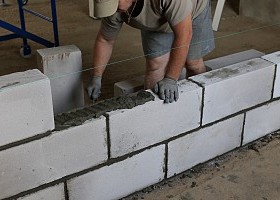
What better to do Partition walls, turned to room isolated from other premises? It is better to use a more dense and durable material, which has high soundproofing. Such partitions in apartments most often set in order to create a separate room for children or working room. There is not only important soundproofing, but the vibration of the walls. What is an alternative drywall? As an option, inner wall may be made of cheaper keramzitoblokov, gipsoblokov and foam blocks.
Internal walls in the apartment are symbolic, but more often simply Decoration. They only visually divide the room into two or more distinct zones. Such interior walls in the apartment often set, eg, in the living room to separate dining room and relaxation areas, in the master bedroom can thus separate the working zone (study) from the main area.
The construction of insulated walls
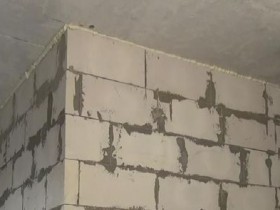
A closer look at ways to erecting insulated walls, eg, internal partitions of foam blocks or keramzitoblokov to obtain secluded space. But first it should be noted, that according to generally accepted standards of the deaf walls can be installed only in rooms with multiple sources of natural light, that is, where there are two or more windows. If the partition is to be erected elsewhere, the need permission from the BTI and drawing up a new project. So the first, consider that - it conditions the installation of partitions in apartment.
Terms of installation of partitions in apartment
It is forbidden to make capital partition in the following cases:
- to increase kitchen space, bathroom or toilet at the expense of living space;
- just reduce the kitchen or bathroom in order to increase the living space;
- equipped with toilet bottom of the neighbors kitchen;
- to carry out the transfer of the kitchen to the living space;
- if there is a gas cooker, It prohibited to combine the kitchen and living room;
- divide the premises into two or more at a natural light source (window).
Except where the installation of partitions, should also take into account some technical aspects, that will determine, from which it is better to make interior walls. These include the following:
- forbidden demolish septum in order to transfer them, if they are carrying;
- installation of heavy walls must be carried out on a solid foundation (reinforced concrete monolithic, brick or block, with its density of at least D600, wall); in other cases the masonry wall thickness of the foam blocks can be made 10 cm is formed on a same framing plasterboard technology.
The table below shows a comparison of several materials by their physical characteristics, is decisive in the choice of a particular type of.
| Specifications | aerocrete | Air blocks | Kyeramzitobloki | Brick |
| Vodopohloschenye | 95 | 85 | 50 | 8 |
| Density | 200-900 | 450-900 | 500-1800 | 1000-1900 |
| Thermal conductivity | 0,1-0,3 | 0,1-0,4 | 0,15-0,45 | 0,3-0,7 |
| Strength | 10-40 | 10-60 | 20-150 | 75-300 |
The table shows, that the warmest material is gas or gas-silicate blocks for partition walls in the apartment, but it has a lower strength because of its high porosity,. The most durable material is a brick, but due to the high density of the material of the weight is very large: 1 m2 masonry weighs 250 kg. In comparison with Gazoblok, by weight of one element is from 5 to 10 kg 600h300h100 size mm, they are more, than in 4 times heavier and, Consequently, create a large load on the overlap. As for the sound insulation characteristics, aerocrete and the concrete blocks have better insulating properties due to the presence of a plurality of gas bubbles. But as can be seen from the table, the difference between the foam of aerated concrete, both types are obvious pros and cons.
Download. Table of cost of partitions from various materials.
Kinds of materials for walls
Brickwork
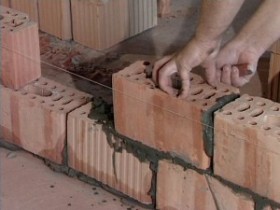
For the construction of partitions in a high humidity necessary to use material with a low coefficient of moisture absorption. Thus has brick or Special moisture-proof gipsobloki green color. In this case, for the walls is best to use a hollow material, t. to. it has less weight, at least 30 %, but it has the same strength.
Masonry as partitions has several advantages:
- high strength and carrying capacity;
- of bricks can build the walls of any curved shape;
- material resistant to humid environments and fungal entities, due to bad vlagovsasyvaemosti he had not formed.
But there are also disadvantages and:
- high partition weight;
- High curvature of the surface after laying, that will require additional plastering, but in the case of mounting the tiles is not critical;
- the high volume of work;
- many accompanying dirt.
Calculator for brick masonry
Partitions from foam blocks and aerocrete
What is different from the aerated foam? These materials are quite similar to each other, but they have a number of differences, which are as follows:
- Mode of production. Aerated concrete blocks are manufactured by baking in an autoclave, in contrast to the foam blocks, which solidify under normal conditions and can be produced directly on the construction site.
- Chemical composition. They contain in its structure a larger quantity of cement, than in the first embodiment, that makes them stronger and more water-resistant.
- Foam blocks are less susceptible to treatment because of the greater proportion of cement.
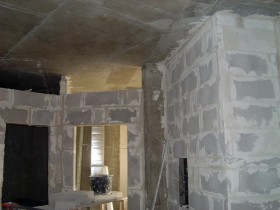
Considering all of the above, we can confidently answer the question, that is stronger - the foam block or gazoblok. naturally penoblok, but it has a smaller thermal insulation coefficient. In particular, for construction of partitions in the apartment is large does not matter.
If the base does not allow to build a massive and very heavy interior walls, then one will be excellent interior partition of foam blocks. But always it is necessary to coat without gaps with the help of tiles, plaster and other means in the case of construction in areas with high humidity.
Today on sale there is a large variety of sizes of foam blocks and aerocrete for building. But for the erection of walls are the so-called partition blocks. Their sizes can be:
- 600h300h100 mm;
- 600h200h100 mm.
Internal partition of the blocks has a number of advantages:
- Installation of partitions from foam blocks made quite quickly due to the small weight of each unit and its impressive size.
- High rates of heat- and sound.
- good fire resistance.
- High performance geometry of the finished masonry.
- Gazo- concrete blocks and easily with all tools (Stameska, hand hacksaw, drill), but it is recommended to use the specially designed for this instrument. Hacksaw should have a thick leaf and be dotted with large double tines.
- When the masonry walls of the foam blocks doorways to 80 cm width can be performed without the use of metal bridges, but only with the use of adhesive mixture. For more information on erecting walls of the foam block.
But just like in any other building, There are some disadvantages, due to the following:
- Gazo- and concrete blocks are deviations in the geometric dimensions to 2 mm, suggesting the need for alignment of wall plasters.
- To prevent the formation of fungi in damp or wet rooms partitions need to be processed antiseptic safeners. It should be on 100 % trimmed plasters.
- Surface less strong, than brickwork.
cam boards
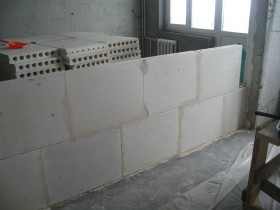
No less interesting are for partitions in apartment blocks or slabs pazogrebnevye. This new material, having an inherently gypsum, hydrophobic plasticizer and other additives to improve water resistance, It has excellent geometrical parameters. Also, each plate has in its structure a groove and a protrusion (crest) to ensure a perfect mating between components, forming a single flat surface.
Gypsum blocks as the building masonry material have several advantages:
- non-flammable, and does not deform under prolonged exposure to fire;
- have excellent geometric parameters, unlike partitions from foam blocks, that speaks about a perfectly flat surface and there is no need for a plaster;
- easily with all tools;
- possess excellent soundproof and heat insulating properties;
- They have a relatively low weight, approximately equal to the volume of material Gazoblok;
- in commercially available plates with voids, that easily allows you to make all the necessary communication wiring;
- lightweight slabs and large geometric dimensions of each unit contribute to the rapid erection of walls and partitions;
- the presence of tongue and groove makes the wall stronger, than a masonry room divider from foam blocks.
As with any other material, cam boards made of gypsum have weaknesses:
- comparative low strength material;
- high water absorption, until fracture - for erecting walls in rooms with high humidity necessary to use a plate with special additives, they are different from the normal green color;
- mounting plates should be used only special gypsum adhesive.
Partitions of lightweight aggregate concrete blocks
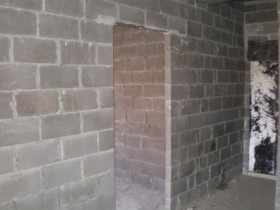
lightweight aggregate blocks for room partitions are also a good choice, because they possess good strength indicators, sound- and thermal insulation, and most importantly, low cost. But should take into account the fact, that possesses stronger material properties less teplosohraneniya. For the erection of walls in the apartment is enough to use elements with large granules of expanded clay. Concrete block also have pros and cons, as described below:
- most fragile lightweight aggregate blocks have a moisture permeability coefficient is much smaller foam blocks, and it is only 50 % vs 85 %;
- less durable lightweight aggregate blocks has a greater strength than the foam blocks, index differs by almost half;
- masonry concrete block can be performed directly on the reinforced concrete base of the apartment, while the gypsum or aerocrete should be mounted on the substrate to compensate for the temperature coefficient;
- these units are not prone to shrinkage, indicating that maintaining the ideal geometry after work for a long time;
- available for sale a variety of sizes and shapes of concrete block, that allows you to build complex shape design.
There is no ideal materials, and therefore this has some drawbacks. Block due to the large number of fired clay granules poorly to treatment with conventional tools, so you need to purchase specially designed for concrete discs.












